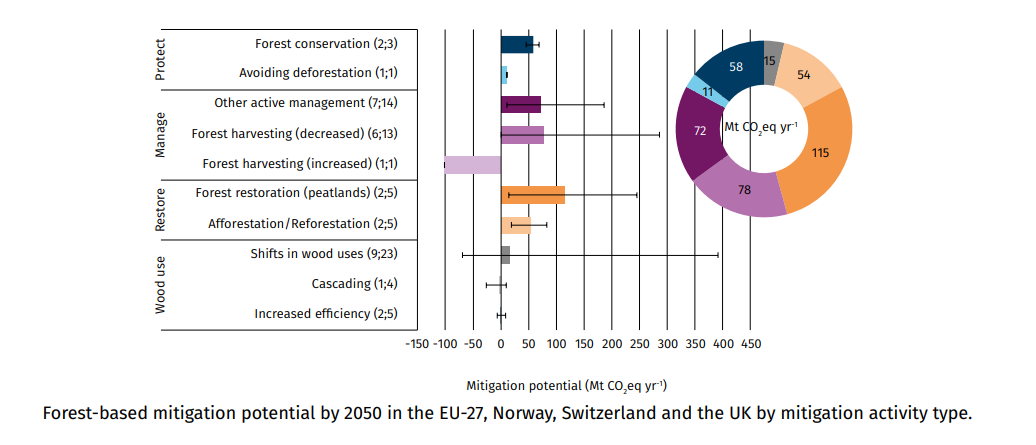DE:Wie können Wälder und Holznutzung zur Erreichung der Klimaziele beitragen?
ES: ¿Cómo el uso de los bosques y la madera puede contribuir a alcanzar los objetivos climáticos?
FR: Comment l’utilisation des forêts et du bois peut-elle aider à atteindre les objectifs climatiques ?
IT: In che modo le foreste e l'uso del legno possono contribuire al conseguimento degli obiettivi climatici?
Authors: Verkerk, P.J., Delacote, P., Hurmekoski, E., Kunttu, J., Matthews, R., Mäkipää, R., Mosley, F., Perugini, L., Reyer, C.P.O., Roe, S., Trømborg, E.
What is at stake?
Forests and forestry play a key role in policy targets to achieve climate neutrality. For example, forests and wood products in the European Union (EU) remove approximately 380 MtCO2 eq/year (compensating about 10% of total annual EU greenhouse gas emissions). According to the European Commission’s proposed policy targets, the EU’s Land Use, Land-Use Change, and Forestry (LULUCF) sector needs to remove in addition approximately 50 MtCO2eq/year by 2030, 100 MtCO2eq/year by 2035, and 170 MtCO2eq/year by 2050.
How much can forests and wood use contribute to climate change mitigation?
Based on a review of the scientific literature, mitigation activities such as avoiding deforestation, afforestation/re- forestation, shifts in wood use, wood cascading and increased efficiency can be combined as they have limited effects on each other and can have positive impacts on biodiversity. When combined they could provide an additional mitigation potential of up to 78 MtCO2eq/year by 2050 in the European Union, Norway, Switzerland and the United Kingdom. This could increase to:
- 136 MtCO2eq/year when combined with forest conservation activities, or
- 150 MtCO2eq/year when combined with other active forest management, or
- 155 MtCO2eq /year when combined with decreasing forest harvest.
Climate change is affecting European forests, forestry, and forest product markets, which can both increase and decrease:
- Carbon sequestration by forests, through shifts in tree species ranges, forest productivity changes and increased disturbance damage.
- Carbon storage in wood products and possible substitution effects through changes in wood quality, supply and costs.
Key messages:
- European forests and wood products can provide a significant contribution to achieve climate neutrality by 2050, but their contribution is finite and cannot compensate for delayed actions in other sectors.
- Limited information is currently available on the related costs and feasibility of realising the forest-based mitigation potential.
- A high degree of uncertainty applies as different scientific studies use different data, methods, system boundaries, types of potential and scenario assumptions.
How can the contribution by forest-based mitigation actions be maximised?
- Adopt a holistic approach that considers all relevant carbon pools and fluxes, as well as interactions between forest-based mitigation activities and with adaptation, and which minimizes trade-offs with biodiversity and ecosystem services.
- Combine multiple forest-based mitigation activities to maximise the effect and foster synergies, interactions, co-benefits and regional applicability.
- Prioritise types of wood use that give the largest net emission reductions.
- Take note that forests across countries differ, and so do implementation actions.
- Move to policy implementation and develop appropriate support tools (e.g., through incentive systems, exchange of best practices, devising a transparent, harmonized and robust monitoring framework).
- Apply a long-term perspective beyond 2050 in climate and forestry policies, that considers climate change mitiga tion and adaptation together to avoid future losses of forest carbon stocks and sequestration capacity.
The technology, capacity and strategies needed to deploy forest-based mitigation measures are readily available and have been used for decades. Maximum efforts, starting with the most sustainable and cost-efficient mitigation activities, should urgently be pursued to reduce net emissions.
Reference
Verkerk, P.J., Delacote, P., Hurmekoski, E., Kunttu, J., Matthews, R., Mäkipää, R., Mosley, F., Perugini, L., Reyer, C.P.O., Roe, S., Trømborg, E. 2022. How can forests and wood use help meet climate goals? Policy Brief 2. European Forest Institute. https://doi.org/10.36333/pb2
